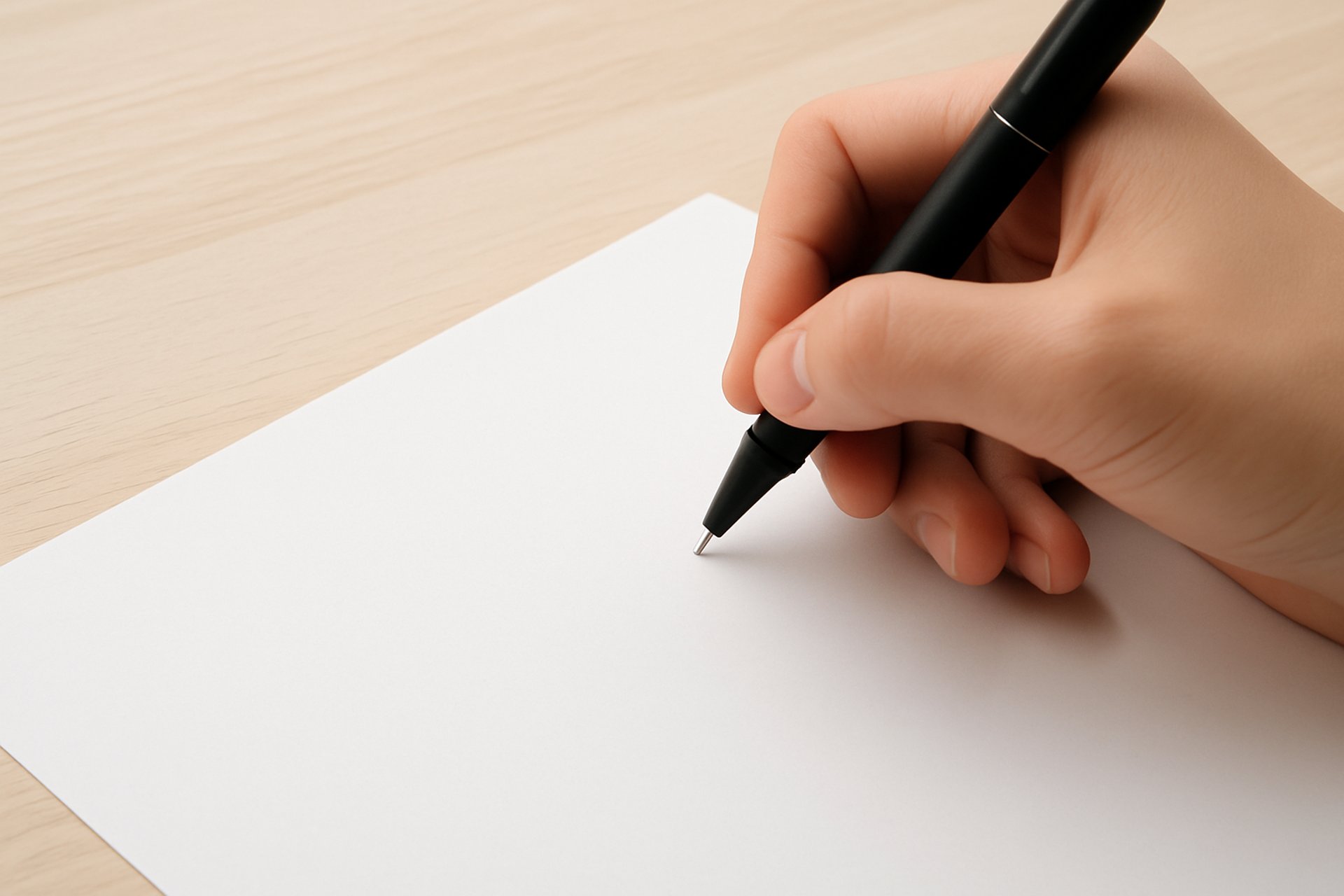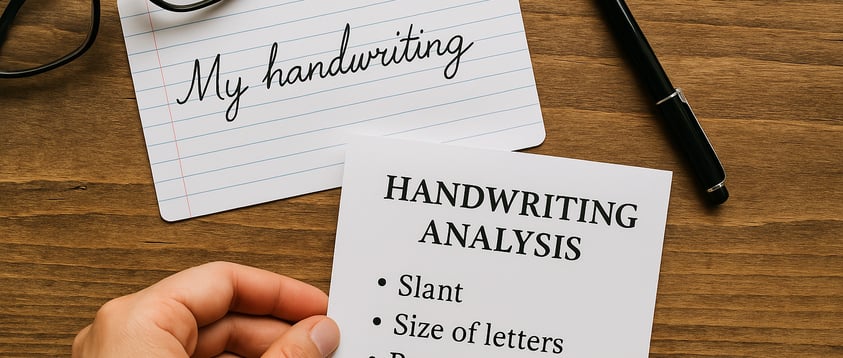
What Your Handwriting Says About Your Personality
Leena
1/10/20254 min read


What Your Handwriting Says About Your Personality: Decoding the Secrets of Graphology
"What if the way you dot your 'i's or cross your 't's could reveal your deepest personality traits?"
It sounds like a wild idea, right? But believe it or not, your handwriting might be saying more about you than your LinkedIn profile. Welcome to the fascinating world of graphology—the science (and art) of analyzing handwriting to understand personality.
Imagine this: you're filling out a form, scribbling a quick note, or jotting down your to-do list. You're not thinking twice about how your letters slant or how big your loops are. But those unconscious choices? They're golden clues into your subconscious.
Just like your fingerprints, your handwriting is uniquely yours. No two scripts are exactly the same. It's a "brain print"—an external expression of your inner thoughts, habits, and emotional wiring. And once you learn how to read it, you'll never look at a handwritten note the same way again.
Let’s break it down and decode what your handwriting is really saying about you.
The Science Behind Handwriting Analysis
Before we dive into traits, let’s talk science.
Handwriting isn’t just a motor skill—it’s a psychomotor expression. That means it reflects both your physical and mental state. The act of writing engages the brain’s cortex, especially the parts related to movement, emotion, and cognition. So when your brain shifts, your handwriting often shifts too.
Carl Jung, the famed psychologist, saw value in handwriting analysis as a window into the psyche. While graphology isn’t mainstream in modern clinical psychology, it continues to gain interest in self-help circles, career coaching, and even law enforcement profiling.
And here’s a kicker: according to a study published in the Journal of Forensic Sciences, handwriting can reflect over 5,000 personality traits. That’s more than any personality quiz on the internet.
Let’s look at some of those traits in action.
Key Handwriting Traits & Their Personality Meanings
Ready to see how your writing style reveals who you are? Here’s how experts interpret some of the most telling handwriting features.
A. Letter Size
Large letters
Outgoing, attention-seeking, confident.
May enjoy being the center of attention or crave recognition.
Small letters
Focused, detail-oriented, introspective.
Often thinkers and analysts who prefer working behind the scenes.
Medium letters
Balanced and adaptable.
Typically well-adjusted to social and solitary situations.
B. Slant of Writing
Right slant
Emotional, social, expressive.
Open to new experiences and people.
Left slant
Reserved, introspective, independent.
May prefer to process feelings privately.
No slant (vertical)
Controlled, pragmatic, balanced.
You’re probably someone who keeps emotions in check.
C. Pressure Applied
Heavy pressure
High emotional intensity.
Strong-willed, persistent, sometimes stressed.
Light pressure
Sensitive, empathetic, flexible.
May be more adaptable but sometimes indecisive.
D. Spacing Between Words & Lines
Wide spacing between words
Values personal space and independence.
You like your freedom and hate feeling crowded.
Narrow spacing
Craves closeness, tends to be sociable.
Can come off as too intense or clingy.
Irregular spacing
Mood-driven or inconsistent energy levels.
You might thrive in creative but chaotic environments.
E. Signature Analysis
Legible signature
Clear sense of self, confidence, and openness.
You own who you are—and you’re not afraid to show it.
Illegible signature
Private, possibly defensive or mysterious.
You may like to keep people guessing.
Real-Life Applications of Handwriting Analysis
You might be wondering—besides being a fun party trick or self-help tool, where else does handwriting analysis actually make an impact? The truth is, graphology goes beyond personality insights. It finds practical use in personal development, criminal investigations, career planning, and even relationship counseling. Let’s explore how this fascinating tool applies to real life:
Self-Awareness
Graphology can be a mirror for self-reflection. By examining your handwriting, you can uncover personality traits that aren’t always visible in day-to-day life. For instance, certain handwriting indicators—like irregular strokes, sharp angles, or exaggerated letter formations—can reveal issues like suppressed anger, low self-esteem, or lingering resentment. Understanding these signs helps you confront emotional baggage and take actionable steps toward personal growth and healing. The more aware you are, the more intentional your growth can be.
Forensic Identification
Handwriting analysis plays a vital role in the world of forensic science. Experts in document examination analyze handwriting to verify signatures, detect forgeries, and even profile suspects based on their writing traits. Law enforcement agencies worldwide rely on handwriting comparison in criminal investigations, fraud detection, and historical document verification. It’s more than personality—it’s legal proof in action.
Career Insights
Handwriting analysis is also finding a place in the hiring and career coaching world. Recruiters and professionals use it to assess key personality traits such as honesty, reliability, leadership style, and creativity.
For instance, tight and neat writing might signal a methodical and disciplined thinker, while expansive, bold letters may indicate confidence and charisma. It’s not a replacement for interviews or formal assessments, but it can serve as a powerful complement to help understand a candidate’s mindset and working style.
Relationship Compatibility
Your handwriting may reveal how you relate to others—whether you’re emotionally expressive, need space, or are more reserved. Relationship coaches and therapists sometimes use graphology to explore compatibility, especially in areas like communication style and emotional alignment. It's an alternative way to identify red flags or strengthen bonds in romantic or even business partnerships.
Grapho-therapy: Change Your Writing, Change Your Life
This is where it gets empowering.
Grapho-therapy is the process of intentionally altering handwriting to influence mindset and behavior. It’s the ultimate feedback loop: change your handwriting, and your brain starts to rewire itself.
For example:
Working on your t can increase your self esteem
working on your i's can help you control your irritation
Smoother strokes help build patience and clarity.
Want a guide through that journey? This is where Handwriting Harmony comes in. It’s a personalized service that combines graphology with grapho-therapy to help you unlock confidence, emotional clarity, and goal-oriented habits—all by working on how you write.
Conclusion: It’s All in the Strokes
Your handwriting is a mirror of your mind. It reveals your personality traits—if you know what to look for. From letter size to slant, from pressure to spacing, every stroke tells a story. Whether you’re just curious or want to go deeper, handwriting analysis offers a unique lens to better understand yourself and others.
Your personality is in your pen—reach out for expert handwriting analysis and transformation.
Insights
Unlock your potential through handwriting analysis today.
© 2025. All rights reserved.
